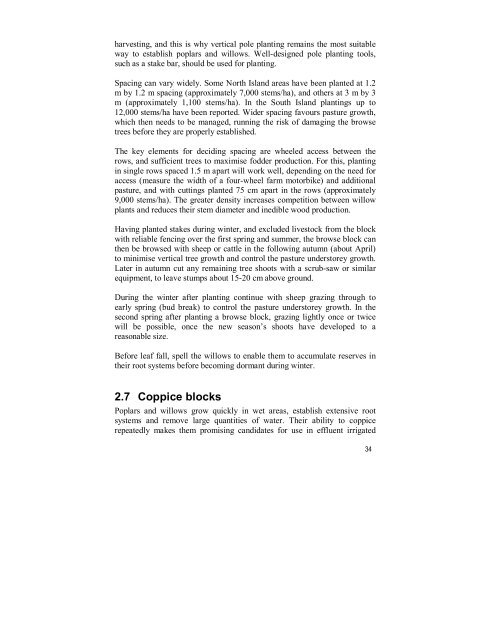Growing Poplar and Willow Trees on Farms, National - FAO
Growing Poplar and Willow Trees on Farms, National - FAO
Growing Poplar and Willow Trees on Farms, National - FAO
You also want an ePaper? Increase the reach of your titles
YUMPU automatically turns print PDFs into web optimized ePapers that Google loves.
harvesting, <str<strong>on</strong>g>and</str<strong>on</strong>g> this is why vertical pole planting remains the most suitable<br />
way to establish poplars <str<strong>on</strong>g>and</str<strong>on</strong>g> willows. Well-designed pole planting tools,<br />
such as a stake bar, should be used for planting.<br />
Spacing can vary widely. Some North Isl<str<strong>on</strong>g>and</str<strong>on</strong>g> areas have been planted at 1.2<br />
m by 1.2 m spacing (approximately 7,000 stems/ha), <str<strong>on</strong>g>and</str<strong>on</strong>g> others at 3 m by 3<br />
m (approximately 1,100 stems/ha). In the South Isl<str<strong>on</strong>g>and</str<strong>on</strong>g> plantings up to<br />
12,000 stems/ha have been reported. Wider spacing favours pasture growth,<br />
which then needs to be managed, running the risk of damaging the browse<br />
trees before they are properly established.<br />
The key elements for deciding spacing are wheeled access between the<br />
rows, <str<strong>on</strong>g>and</str<strong>on</strong>g> sufficient trees to maximise fodder producti<strong>on</strong>. For this, planting<br />
in single rows spaced 1.5 m apart will work well, depending <strong>on</strong> the need for<br />
access (measure the width of a four-wheel farm motorbike) <str<strong>on</strong>g>and</str<strong>on</strong>g> additi<strong>on</strong>al<br />
pasture, <str<strong>on</strong>g>and</str<strong>on</strong>g> with cuttings planted 75 cm apart in the rows (approximately<br />
9,000 stems/ha). The greater density increases competiti<strong>on</strong> between willow<br />
plants <str<strong>on</strong>g>and</str<strong>on</strong>g> reduces their stem diameter <str<strong>on</strong>g>and</str<strong>on</strong>g> inedible wood producti<strong>on</strong>.<br />
Having planted stakes during winter, <str<strong>on</strong>g>and</str<strong>on</strong>g> excluded livestock from the block<br />
with reliable fencing over the first spring <str<strong>on</strong>g>and</str<strong>on</strong>g> summer, the browse block can<br />
then be browsed with sheep or cattle in the following autumn (about April)<br />
to minimise vertical tree growth <str<strong>on</strong>g>and</str<strong>on</strong>g> c<strong>on</strong>trol the pasture understorey growth.<br />
Later in autumn cut any remaining tree shoots with a scrub-saw or similar<br />
equipment, to leave stumps about 15-20 cm above ground.<br />
During the winter after planting c<strong>on</strong>tinue with sheep grazing through to<br />
early spring (bud break) to c<strong>on</strong>trol the pasture understorey growth. In the<br />
sec<strong>on</strong>d spring after planting a browse block, grazing lightly <strong>on</strong>ce or twice<br />
will be possible, <strong>on</strong>ce the new seas<strong>on</strong>’s shoots have developed to a<br />
reas<strong>on</strong>able size.<br />
Before leaf fall, spell the willows to enable them to accumulate reserves in<br />
their root systems before becoming dormant during winter.<br />
2.7 Coppice blocks<br />
<str<strong>on</strong>g>Poplar</str<strong>on</strong>g>s <str<strong>on</strong>g>and</str<strong>on</strong>g> willows grow quickly in wet areas, establish extensive root<br />
systems <str<strong>on</strong>g>and</str<strong>on</strong>g> remove large quantities of water. Their ability to coppice<br />
repeatedly makes them promising c<str<strong>on</strong>g>and</str<strong>on</strong>g>idates for use in effluent irrigated<br />
34

















